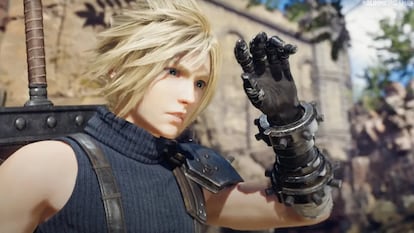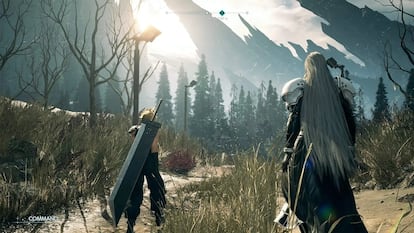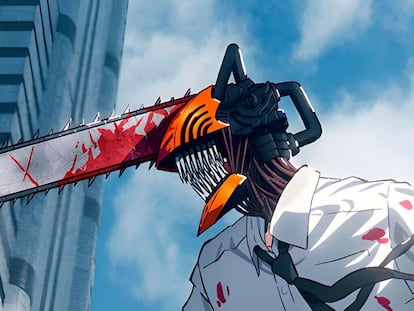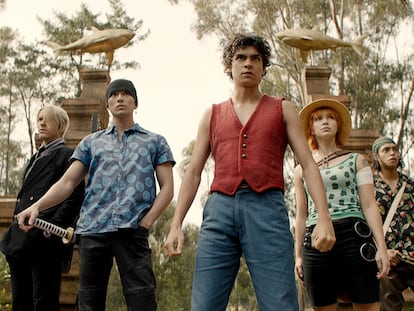‘Final Fantasy VII Rebirth’: The reincarnation of the greatest story ever played
The second part of the extraordinary video game, the original of which was released 27 years ago, is set to be one of the hits of the year

Let’s talk a little about Tetsuya Nomura, a 53-year-old video game designer born in Kōchi, Japan. At the end of the 1990s, when he was a developer at the Tokyo-based Square Enix, he knocked on the door of The Walt Disney Company with a practically suicidal idea. He wanted to make a video game that mixed the characters, mechanics and combat of Final Fantasy with the most iconic Disney characters. That is, a video game in which the protagonist lived an epic plot line in which he had to fight a dark force that threatened the universe... but whose companions were Donald, Goofy, Mickey, and other classic characters.
Miraculously, by the time the year 2000 rolled around, Nomura had managed to convince all parties.
Kingdom Hearts came out in 2002. With 35 million copies sold, it was a meteoric success. More importantly, its mix of exploration of Disney worlds in various dimensions (including the fictional settings of Aladdin, The Jungle Book, The Little Mermaid and Peter Pan) — plus the hallmarks of Final Fantasy — turned it into a universe that contained the potential of all the most special animated works. As it evolved in the collective unconscious, many thought that Nomura’s creation could measure up to the most mythical sagas, such as Star Wars, The Lord of the Rings and Harry Potter. The protagonist of Kingdom Hearts — Sora, armed with his keyblade — was on the verge of becoming an immortal character.
This didn’t happen. The first two installments of the game were great… but in the 14 years between the second (2005) and the third (2019), there was a whole string of sequels, prequels and intersequels (358/2 Days, Re:Coded, Birth by Sleep, Melody of Memory, Dream Drop Distance) that sought to enrich the universe… yet they only managed to entangle it until it became absurdly complex. The developers lost a large part of their followers along the way. To make matters worse, the highly-anticipated Kingdom Hearts III was very disappointing. The saga had lost its magic.
In 2020, a long-awaited project — which seemed like a lie — arrived on the market: the remake of Final Fantasy, the game that changed everything. In 1997, Final Fantasy had brought Japanese role-playing to the rest of the world on a large scale… and Nomura was behind it. By then, his name had already raised some eyebrows.
The hopes of the franchise, in reality, were placed on Final Fantasy XVI (which came out last year) while the remake of Final Fantasy VII would also only cover the first city of the original work. In total, the remake would consist of three games. Furthermore, there was also a sort of philosophical clash: the Final Fantasy VII remake was too much like a work of anime, with the characters’ hair standing on end, giant swords and talking lions. Final Fantasy XVI on the other hand was something serious, based more on Game of Thrones than anything else. This version exuded a seriousness, a maturity and an esthetic sobriety that seemed to be the light that would guide the franchise from that moment onwards.

The Final Fantasy VII remake (which, in a crazy semantic script twist, was actually revealed to be a reboot, because it modified a substantial part of the plot) was far more popular than expected. The photorealistic graphics turned out to fit the anime esthetic and spirit of the game. Meanwhile, the XVI version was the great disappointment of 2023, a year marked by monumental video game releases in which it wasn’t up to par.
Two weeks ago, journalists from all over Europe were invited to London to try out the game (including this writer). Some had already tried a preliminary version, but this time, the one that’s destined to be the jewel in the crown of the franchise (if all goes well) or its biggest failure (if everything goes wrong) was available: Final Fantasy VII Rebirth Open World. The story takes place just as the group of heroes leaves the city of Midgard, after fighting the mythical character Sephiroth. The protagonists subsequently cover the central terrain of the 1997 game.
Without a doubt, this game couldn’t look better. The exploration is complex and the open scenarios meet all expectations. The progression of the story — such as the relationship between the protagonist (Cloud Strife) and Sphiroth, which is told through well-written playable flashbacks — has a very firm pace. The combat is an evolution of the previous one, which was already in real-time. And exploration is of a much higher standard.
But the most important thing is that, beyond the mechanics of the game — and beyond exploiting a story and characters that have already been amply proven to dazzle people — it unapologetically embraces the anime spirit that I looked at with reluctance in the work that was released four years ago. In today’s version, the animations are unceremoniously exaggerated, the cities are a fortunate mix of different esthetics and it accepts, without embarrassment, the dreamy spirit and rawness of the 1997 game.
As one of the best games in the franchise, Final Fantasy VII Rebirth gets to the heart of the magic that the saga so boldly seeks. In short, solemnity has been banished and, starting on February 29, the purest recreational enjoyment that this business can offer awaits us players. Everything seems to indicate that a new final fantasy has arrived before the end of the fantasy.
Sign up for our weekly newsletter to get more English-language news coverage from EL PAÍS USA Edition
More information










































